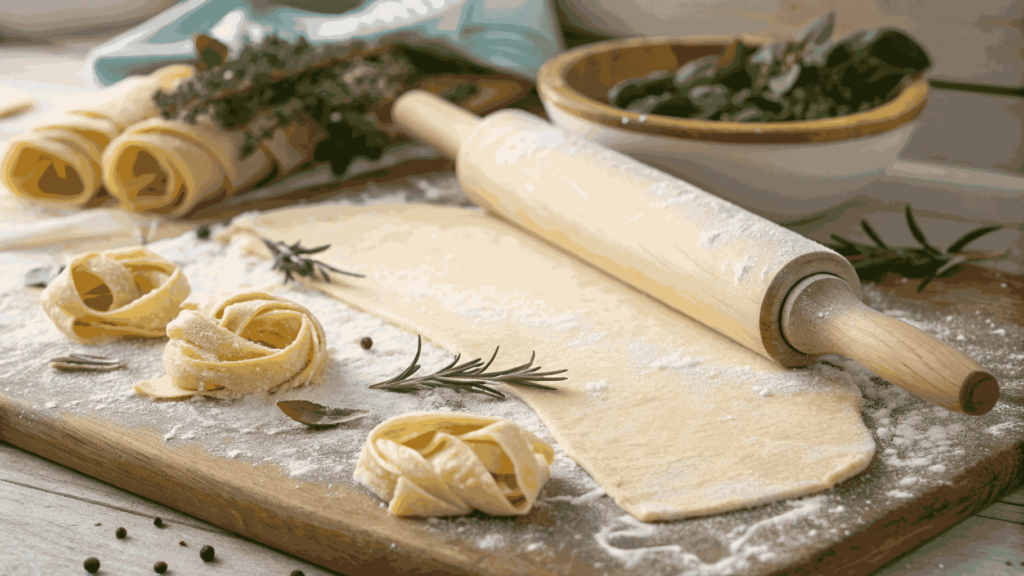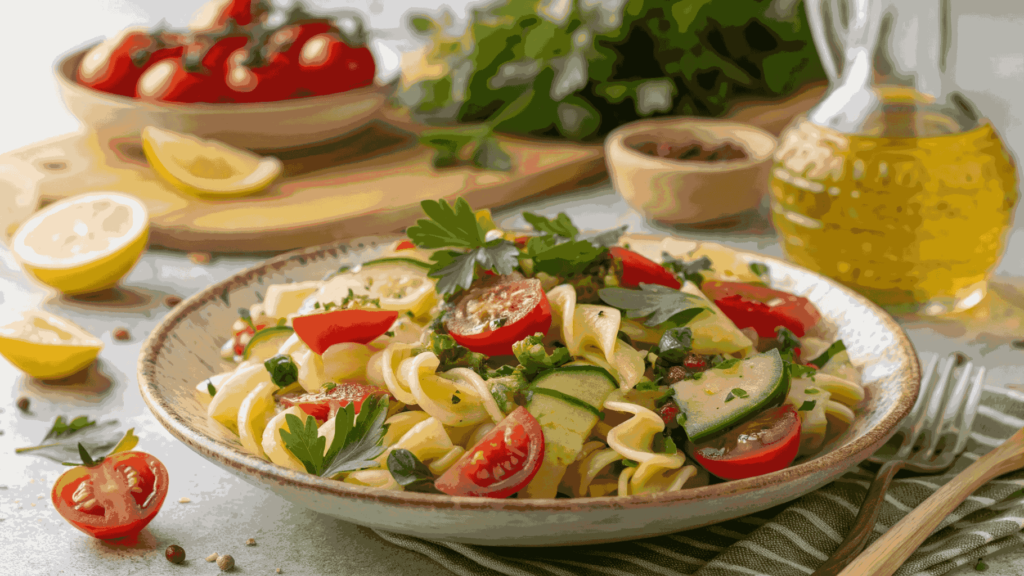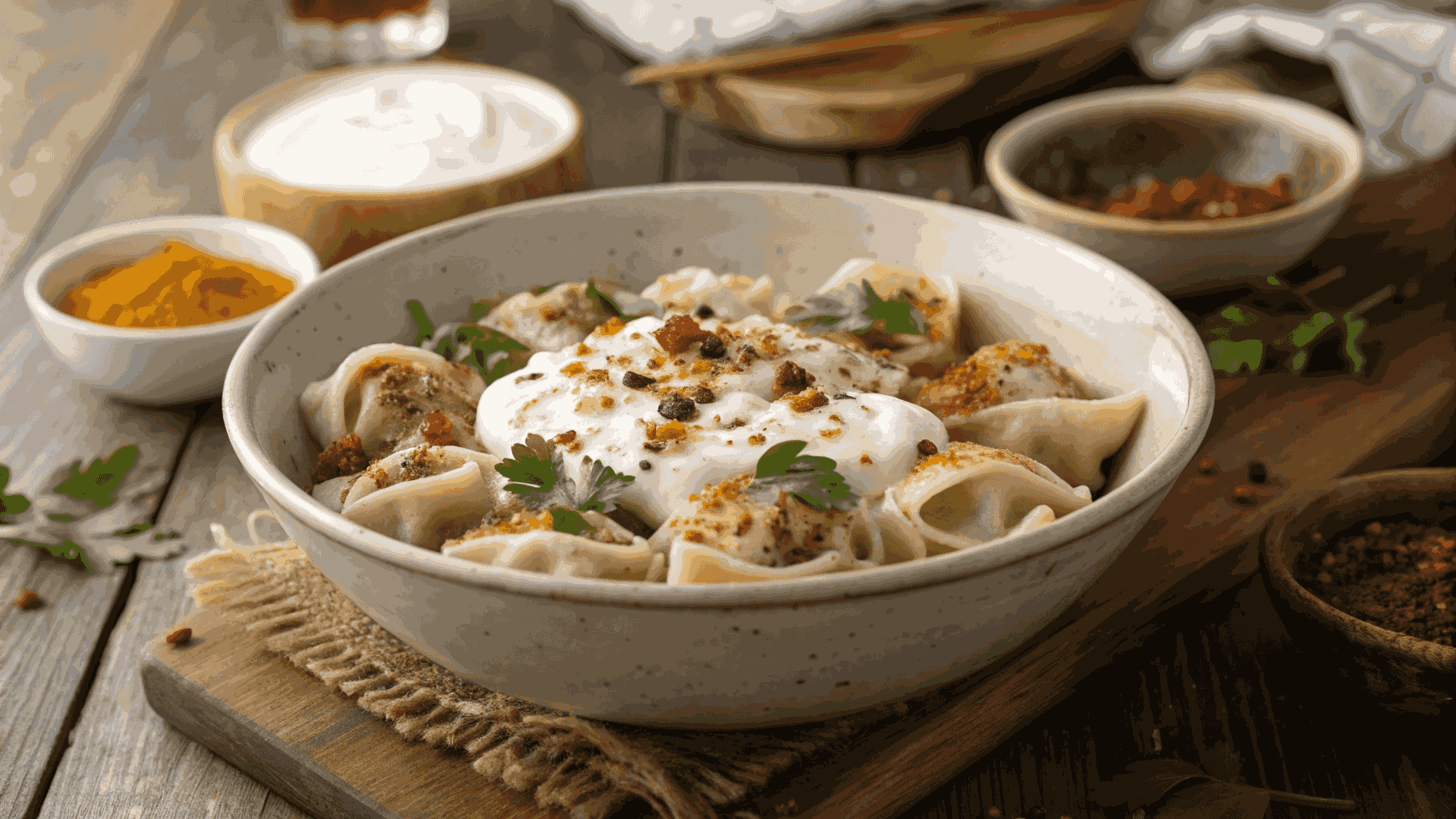Introduction to Turkish Pasta
What is Turkish Pasta?
Turkish pasta, often called makarna or yufka (depending on the type), features a variety of homemade noodles and dough-based dishes that hold a vital place in Turkish cuisine. These pasta recipes stand out because people often serve them with rich sauces, meats, or vegetables. Unlike traditional Italian pasta, Turkish pasta typically appears in hearty stews, soups, or baked dishes, making it a comforting and satisfying meal. Turkish pasta dishes have also gained popularity in other countries where Turkish communities live.
Cultural Significance of Turkish Pasta
Turkish pasta has a deep cultural significance. In Turkey, food symbolizes family, tradition, and celebration. For example, the preparation of pasta, like Manti, a Turkish dumpling-style pasta, often becomes a family activity passed down through generations. People typically serve these pasta dishes during gatherings, holidays, and special occasions. Turkish pasta is more than just food; it represents shared experiences and brings people together, highlighting the importance of food in Turkish culture.
Key Ingredients in Turkish Pasta
Traditional Ingredients for Turkish Pasta
Several ingredients are essential for creating authentic Turkish pasta. Flour, combined with water and salt, serves as the base for the dough. This mixture forms a dough that can be shaped into various forms, such as Manti (dumplings), Yufka (thin flatbreads), or thick noodles used in dishes like Kisir. For sauces, Turkish pasta recipes often use yogurt, ground meat (usually beef or lamb), tomatoes, onions, and garlic. These ingredients provide the distinctive and bold flavors that define Turkish pasta dishes.
Substitutes for Authentic Turkish Pasta Ingredients
If you cannot find specific Turkish ingredients, try using substitutes. For instance, if you can’t find yufka (traditional Turkish flatbread), use phyllo dough or regular pasta sheets instead. Ground lamb, which is common in Turkish pasta dishes, can easily switch to ground beef or chicken based on your preferences. This flexibility ensures that you can still enjoy Turkish pasta dishes, even if you don’t have access to every traditional ingredient.
How to Make Turkish Pasta: Step-by-Step Recipe

Step 1: Preparing the Dough for Turkish Pasta
Start by preparing the dough. Mix about 2 cups of flour with a pinch of salt, then gradually add water, stirring until the dough becomes smooth and elastic. Knead the dough for 8-10 minutes to achieve a firm and stretchy texture. After kneading, let the dough rest for 30 minutes. This resting period is crucial because it allows the gluten to relax, making it easier to roll out later.
Step 2: Rolling and Cutting the Dough
Once the dough has rested, roll it out. Use a rolling pin to flatten the dough on a floured surface until it reaches about 1/8 inch thick. At this point, you can either use a sharp knife to cut the dough into small squares or long strips, depending on the dish you’re making. For Manti, roll the dough into small, round pieces or squares. Then, fill each piece with your choice of filling and pinch them into a dumpling shape.
Step 3: Cooking the Pasta to Perfection
Bring a large pot of salted water to a boil. Once the water is boiling, drop the pasta into the pot and cook it for about 5-8 minutes. Since Turkish pasta is fresh, it cooks quickly, so check for doneness frequently. After the pasta becomes tender but still slightly firm to the bite, drain it well and set it aside.
Step 4: Making the Sauce to Complement Turkish Pasta
Now, prepare the sauce. Begin by sautéing onions and garlic in olive oil until golden. Next, add ground beef or lamb and season with spices like cumin, paprika, and black pepper. Cook the meat until it browns completely. To enrich the flavor, stir in a spoonful of tomato paste and simmer for a few minutes. Once the pasta is cooked and drained, serve it with the rich sauce. Finish the dish by topping it with a creamy yogurt sauce and fresh herbs.
Popular Turkish Pasta Dishes
Turkish Manti: The Iconic Dumpling Dish
Turkish Manti is one of the most well-known pasta dishes. These tiny dumplings get filled with seasoned ground meat, such as lamb or beef, and flavored with spices like cumin and paprika. After boiling, serve Manti with a tangy yogurt sauce, garlic, and hot butter infused with chili flakes. This dish is a beloved Turkish comfort food that is rich, satisfying, and packed with flavor. Additionally, regional variations of Manti exist throughout Turkey, each adding unique twists to the filling or cooking method.
Kisir: Turkish Pasta with a Twist
Unlike the hearty Manti, Kisir offers a lighter variation of Turkish pasta. This dish uses short pasta, mixed with olive oil, lemon juice, fresh herbs like parsley, and diced vegetables. It’s a refreshing, salad-like dish, popular during the warmer months. Kisir often accompanies grilled meats or forms part of a mezze platter, but it also works as a main course on its own.
Pide: Turkish Pasta’s Flatbread Cousin
Though Pide isn’t exactly pasta, it shares similarities with Turkish dough-based dishes. This dish resembles pizza but uses Turkish dough and features a variety of toppings like cheese, ground beef, and vegetables. Pide is a popular comfort food, often eaten for breakfast, lunch, or dinner. Its dough-based structure makes it another example of how versatile Turkish dough can be.
Variations of Turkish Pasta Recipes
Turkish Pasta with Beef Mince
One common variation of Turkish pasta includes beef mince. Ground beef often appears in Manti or as a topping for pasta. The beef gets seasoned with spices like cumin, paprika, and black pepper, which enhance the fresh pasta’s flavors. You can also add onions, garlic, and tomatoes to create a flavorful sauce that coats the pasta, adding depth to the overall dish.
Turkish Pasta with Vegetables and Herbs

For a vegetarian alternative, make Turkish pasta with an assortment of vegetables like spinach, mushrooms, and tomatoes. After boiling the pasta, toss it with sautéed vegetables, fresh herbs like dill or parsley, and a dollop of creamy yogurt. This variation is light, refreshing, and perfect for a healthy lunch or dinner. By adding more herbs and vegetables, you can create a nutritious dish without sacrificing flavor.
How to Serve Turkish Pasta
Classic Ways to Serve Turkish Pasta
Turkish pasta often comes with a yogurt-based sauce, a hallmark of many dishes. For example, Manti traditionally gets topped with garlic yogurt and hot, spiced butter. The richness of yogurt balances the savory meat filling, making for a satisfying dish. To complement the meal, top your pasta with fresh herbs like mint or dill, which will enhance the dish’s flavor.
Pairing Turkish Pasta with Traditional Turkish Sides
In Turkey, pasta dishes frequently pair with traditional sides like Ayran, a yogurt-based drink that refreshes the palate, or Ezme, a spicy tomato and pepper salad. These sides add variety to the meal and complement the pasta’s flavors. Additionally, serve Pilav (Turkish rice) as a common side dish, providing a comforting starchy element.
Tips for Perfecting Turkish Pasta
Tips for Making the Best Turkish Pasta Dough
For the best Turkish pasta dough, use high-quality flour and gradually add water to form a smooth, firm dough. Knead the dough thoroughly for 8-10 minutes to develop gluten, which will result in elastic dough. Let the dough rest to make rolling it out easier.
Common Mistakes to Avoid When Preparing Turkish Pasta
Avoid overcooking the pasta, as fresh Turkish pasta cooks quickly. Keep an eye on the pasta while boiling and check it frequently for doneness. Additionally, don’t use excessive flour when rolling out the dough, as this can make it dry. Ensure your dough remains moist enough to roll easily without cracking.
Health Benefits of Turkish Pasta
Nutritional Value of Turkish Pasta
Turkish pasta provides a good source of carbohydrates, especially from the flour in the dough. Depending on the ingredients, these dishes can also supply protein from meat and healthy fats from olive oil and yogurt. Additionally, many Turkish pasta recipes include fresh vegetables, providing fiber, vitamins, and minerals that are beneficial for overall health.
How to Make Turkish Pasta Healthier
To make Turkish pasta healthier, substitute whole wheat flour for regular flour to increase fiber content. Opt for lean meats like chicken or turkey, and incorporate more vegetables to boost the dish’s nutritional value. Reducing the amount of butter and oil used in the sauce will help lower the overall calorie count.

Traditional Turkish Manti with Yogurt Sauce
Equipment
- Rolling Pin
- Knife
- Large pot
- Frying Pan
- Strainer
Ingredients
- 2 cups all-purpose flour
- 1 large egg
- 1/2 teaspoon salt
- Water as needed
- 1/2 pound ground beef or lamb
- 1 medium onion finely chopped
- 1 tablespoon olive oil
- 1 teaspoon cumin
- 1 teaspoon paprika
- Salt and pepper to taste
- 1 cup yogurt
- 1 tablespoon garlic minced
- 2 tablespoons butter
- 1/2 teaspoon red chili flakes
- Fresh parsley for garnish
Instructions
- Prepare the Dough:
- In a large mixing bowl, combine flour, salt, and egg. Gradually add water and mix to form a smooth dough. Knead for about 8-10 minutes until the dough is firm and elastic. Cover and let rest for 30 minutes.
- Make the Filling:
- In a skillet, heat olive oil over medium heat. Add chopped onions and cook until soft. Add the ground meat and cook until browned. Stir in cumin, paprika, salt, and pepper. Remove from heat and let cool.
- Roll and Shape the Pasta:
- Roll the rested dough into thin sheets, then cut into small squares. Place a teaspoon of the filling in the center of each square and pinch the edges together to form dumplings (Manti).
- Cook the Pasta:
- Bring a large pot of salted water to a boil. Drop the Manti into the water and cook for 5-8 minutes until they float to the surface.
- Prepare the Sauce:
- In a small pan, melt butter and add red chili flakes. In a separate bowl, mix yogurt and minced garlic.
- Assemble the Dish:
- Once the Manti are cooked, drain them and place on a serving plate. Top with the garlic yogurt sauce, then drizzle with the spiced butter. Garnish with fresh parsley.
Notes
- For a spicier dish, increase the chili flakes or add chili paste to the sauce.
- Manti can be made ahead of time and frozen before cooking. Just drop them directly into boiling water when ready to cook.
- Feel free to adjust the filling with different meats, or even make a vegetarian version using mushrooms and spinach.
Frequently Asked Questions about Turkish Pasta
To make Turkish pasta, mix flour, water, and salt to form dough. After kneading, roll the dough out and cut it into shapes. Boil the pasta in salted water, then serve with a rich sauce, like yogurt and hot butter or tomato-based sauce.
Yes, beef mince is a popular choice in Turkish pasta. Ground beef often appears in Manti or as a topping for pasta. Season the beef with spices like cumin and paprika for added flavor.
The most popular Turkish pasta is Manti, a type of dumpling filled with ground meat. Other variations include Yufka, a thin, unleavened dough, and various noodle-based dishes.
You don’t need special equipment to make Turkish pasta. Roll out the dough with a rolling pin and use a sharp knife to cut it into shapes. If you lack a pasta maker, hand-shape the dough into your preferred form.
Conclusion: Embracing Turkish Pasta at Home
Why Turkish Pasta is Worth Trying
Turkish pasta is worth trying because it offers a unique, flavorful experience that blends history, culture, and delicious ingredients. Whether you’re preparing Manti or making your own fresh pasta from scratch, Turkish pasta dishes provide a culinary adventure rich in flavor.
A Final Word on Enjoying Turkish Pasta with Loved Ones
Ultimately, Turkish pasta tastes best when shared with family and friends. The dishes bring people together, allowing everyone to savor the flavors while sharing memories. Whether you make it for a special occasion or a simple weeknight meal, Turkish pasta will delight your taste buds and create lasting moments.

